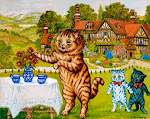It seemed I just procrastinated one day, each day, at last a bunch of days accumulated unattended. This habit of procrastination is a silent killer and imagine the collective procrastinations in evolutionary steps of humans... mmmm .... by this time we would have been super-humans... controlling everything by psychic power...!!!
Let us hear what Dr. Linda Sapadin saying about procrastination styles. There are basically six styles, I will check one by one to see what style fits me:
(you also check yourself)
1. The perfectionist... procrastinating all works in anxiety that he or she couldn't do it in the perfect'est' way! ( If i say this is my style that would be a perfect lie!) (my friend took time off and gathered his courage to propose his sweet heart, charted out enormous plan to propose perfectly ... at last he fixed a date and went to meet her...that's her date too ... she was screaming aloud... in labor pain.... oh! that 's painful isn't it?... certainly i am not the one who advised him to take time out... hee... hee... i mean that loooooooooong!)
2. The crisis maker... self-explanatory! (as a psychiatrist i should be a crisis breaker... but from a scientologist point of view i could fit into this style... as that point of view is quiet twisted... i dare not to get my neck sprained)
3. The dreamer... quenching all his thirst in dreams, hence able to procrastinate to go near a pot to take the tumbler of water. (I dreamed that people from all parts of world checking in to my blog and when I clicked on the link of comments, the computer angrily said it would take two months and 13 days to open up all the comments for the single post... do i fit here?)
4.The defier... ( why should i blog? why should i **** **** do that? why should i .... @#@&^$^^... hey! why are you closing my mouth? no! no! certainly not my style, it needs some guts to defy, you know!)
5.The worrier... what if that causes this and this leads to that and this 'that' and that 'this' combined together to do this and that and what if... ( psychiatrist always think 'what if not'...
what if not they have found prozac? from practice point of view that's horrible to think!)
6.The overdoer... saying yes to 'all' .
do you duty this week for me?
yes! ...
and one more small obligation do the next week duty too, i have lot of personal problems to attend to, you know !
(which psychiatrist didn't have a personal problem?)
yes...
you are the right one to treat that man with that particular personality trait... could you?
yes...
anyway why haven't you blogged so far?
(mmmm... whether this is called sarcasm!)
so i fit somewhere in between dreamer and over doer! where do you fit?
Style #1: Perfectionist. Reluctant to start or finish a task because they don't want anything less than perfect.
Personality Type: Critical |
Style #2: Dreamer. They don't like details. This makes ideas difficult to implement.
| Personality Type: Fanciful Thinking Style: Vague Speaking Style: I wish... Acting Style: Passive Psychological need for: Being special |
Style #3: Worrier. They have an excessive need for security, causing them to fear risk. They fear change, causing them to avoid finishing projects so they don't have to leave the comfort of the "known."
| Personality Type: Fearful Thinking Style: Indecisive Speaking Style: What if...? Acting Style: Cautious Psychological Need For: Security |
Style #4: Defier. A rebel seeking to buck the rules. By procrastinating, they are setting their own schedule -- one that nobody else can predict or control. More subtle forms are called passive-aggressive.
| Personality Type: Resistant Thinking Style: Oppositional Speaking Style: Why should I...? Acting Style: Rebellious Psychological Need For: Non-conformity |
Style #5: Crisis-Maker. Addicted to the adrenaline rush of living on the edge.
| Personality Type: Over-emotional Thinking Style: Agitated Speaking Style: Extremes - "Unbelievable" Acting Style: Dramatic Psychological Need For: Attention |
Style #6: Over-Doer. Says yes to too much because they are unable or unwilling to make choices and establish priorities. They have difficulty making decisions. Prime candidate for burnout.
| Personality Type: Busy Thinking Style: Compelled Speaking Style: Can't say "no" Acting Style: Do-it-all Psychological Need For: Self-reliance |










.jpg)